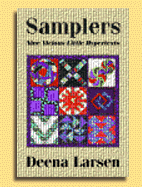 |
| From Samplers: Nine Vicious Little Hypertexts by Deena Larsen. Published by Eastgate Systems. Reproduced by permission. |
Weaving, stitching, sewing, spinning: these are some of the most pervasive metaphors used in connection with the World Wide Web. They are also metaphors that resurface again and again in feminist hypertext. It is not surprising in a disjunctured form composed of blocks of text and images that authors use these ideas in connection with other art forms, altering them metaphorically to become organizing structures and subversive political discourses for their fictions. Regarding narrative structure, Barbara Page says that:
women experimentalists are strikingly self-reflexive and write about their texts in the text. One important difference, though, concerns the self-conscious will among these writers not to simply reimagine writing as weaving but rather to take apart the fabric of inherited textual forms and to reweave it into new designs. For all of these authors, restiveness with the fixity of print signifies something more than a struggle going on under a blanket of established formal meaning. Their aim is to rend the surface of language and to reshape it into forms more hospitable to the historical lives of women and to an esthetic of the will and desire of a self-apprehended female body that is an end unto itself and not simply instrumental (2).
Feminist hypertext, through privileging subjectivity and making explicit its own ruptures, particularly follows this model of revisioning the structural parts of narrative. For Shelley Jackson, for example, it is Mary Shelley's female monster's stitched form that comprises the patchwork (body) parts of the narrative in Patchwork Girl or a Modern Monster. Deena Larsen's Samplers: Nine Vicious Little Hypertexts is devised around nine quilting patterns: Mystic Knot, Crossed Ends, Seed Voices, Century Cross, Firewheel, Interlocked, Caught Out, Structures and Devil's Claws (see illustration above.) Carolyn Guyer's novel Quibbling and her essay "Fretwork: ReForming Me" perform literal weavings of voice and hems and colours and sensations.
These are not the only weavings that take place in hypertext. George Landow (via Jacques Derrida in Speech and Phenomena) proposes that hypertext is a Derridean 'assemblage':
The word 'assemblage' seems more apt for suggesting that the kind of bringing together proposed here has the structure of an interlacing, a weaving, or a web, which would allow the different threads and different lines of sense or force to separate again, as well as being ready to bind others together (qtd, Landow 9).
Hypertext not only binds author and reader together in a symbiotic relationship, but it is particularly adaptable to dialogue and collaborative work. Innately collective, hypertext embodies the hum of the hive with its buzz of bodies clamouring over bodies. Judy Malloy's collaborative hypertext My Name is Scibe originated out of a need for dialogue during a long period of hospitalization. Her joint work with Cathy Marshall, Forward Anywhere, is an extremely sophisticated dialogue built around correspondence and associational links. In the same manner, Raquel Rivera (Malaysia) and Jeannette Lambert (Canada) have written a number of collaborative hypertexts spanning the gaps and the distance between their countries and cultures.
The elaborate Madame de Lafayette's Book of Hours is an intriguing experiment in collaboration. Directed by Christy Sheffield Sanford, each hour will be designed by a different--although Sanford has done two--artist/author (the work is still in progress) as an intertext to de Lafayette's original eighteenth century work. To date the most interesting are Sanford's Body-Church and the two-part hour The Woman in the Fountain and The Portrait, as well as M.D. Coverley's The Lacemaker, Elys. Facing the same problem that Patricia Seaman is grappling with in New Motor Queen City, the different hours are such intensely personal visions that is difficult to see the Book of Hours project as a whole (yet). Both projects remain exciting explorations in what is possible when differing visions and ideas are knitted together and woven apart in unusual ways.
Just as voices weave and stitch together in feminist hypertext, Sadie Plant has traced the intertwining connections between the feminine arts and the history of the computer itself:
The computer was always a simulation of weaving; threads of ones and zeros riding the carpets and simulating silk screens in the perpetual motions of cyberspace. It too presents the screens, the clothing of the matrix, already displaying the virtual machinery of which nature and culture are the subprograms, and joins women on and as the interface between man and matter, identity and difference, the actual and the virtual (Plant 134).
Where this honeycomb patterning of voices will lead in future configurations of cyberspace and in feminist hypertext is impossible to predict, given the phenomenal rate of technological growth and change. What is clear is that the feminist hypertext hive is expanding and radical experimentation has barely even begun.

Carolyn Guertin